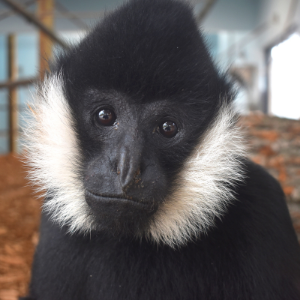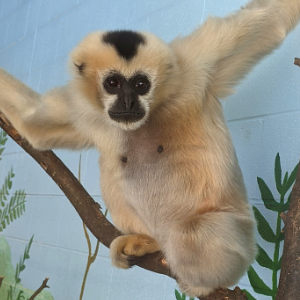With the opening of Lehner Family Foundation Wild Asia on May 29, the Akron Zoo is excited to debut several species from Asia, including a primate species new to the zoo: northern white-cheeked gibbons. Wild Asia will feature one of the largest and most complex AZA gibbon habitats in the northern United States. The space includes an outdoor yard, indoor habitat, and multiple behind-the-scenes bedrooms.
 “Everything is nice, new and clean!” says Brenna Erjavec, primary gibbon keeper. “Our gibbons have tons of space, and they can make choices about where they want to be and what they want to be doing. Additionally, the gibbon building has separate HVACs for the animal area and the keeper area, so the gibbons are breathing clean filtered air that is not shared with their keepers, and vice versa. Primates are incredibly susceptible to human illnesses, and this system is an amazing way to keep animals safe, especially during a pandemic.”
“Everything is nice, new and clean!” says Brenna Erjavec, primary gibbon keeper. “Our gibbons have tons of space, and they can make choices about where they want to be and what they want to be doing. Additionally, the gibbon building has separate HVACs for the animal area and the keeper area, so the gibbons are breathing clean filtered air that is not shared with their keepers, and vice versa. Primates are incredibly susceptible to human illnesses, and this system is an amazing way to keep animals safe, especially during a pandemic.”
Milo and Parker, our two new gibbons, first met at the Cheyenne Mountain Zoo two years ago and arrived at the Akron Zoo together in October of 2020. They are adjusting well to their new home, and it is clear to keepers that the two enjoy each other’s company. Milo, our male, is 21 years old and can be identified by his black coat with white cheek pads. He is braver, more curious, and more personable than Parker with more silly antics. Parker, our 19-year-old female, is more careful, cautious, and thoughtful. However, she's far more athletic than Milo, and can often be seen doing impressive gymnastics throughout their habitat. Parker can be identified by her tan fur and black and white crown. Both are known to be mischievous and inquisitive, and they love interacting with enrichment, especially when there is fruit involved.
 In their native habitat, gibbons have adapted to life in the treetops. They have long arms and long fingers that allow them to brachiate, or swing hand over hand, through the trees. Gibbons can also walk on their shorter back legs while raising their long arms for balance, though this is a much slower way to travel. They live in family groups of two to six individuals. Female gibbons usually give birth to one offspring at a time. The young are able to cling to their mothers immediately after birth, giving mom a full range of motion, and they stay with their family group until they are five to eight years old, when they are old enough to begin their own family. Today there are 17 species of gibbon found throughout Asia, all of which are endangered with decreasing populations.
In their native habitat, gibbons have adapted to life in the treetops. They have long arms and long fingers that allow them to brachiate, or swing hand over hand, through the trees. Gibbons can also walk on their shorter back legs while raising their long arms for balance, though this is a much slower way to travel. They live in family groups of two to six individuals. Female gibbons usually give birth to one offspring at a time. The young are able to cling to their mothers immediately after birth, giving mom a full range of motion, and they stay with their family group until they are five to eight years old, when they are old enough to begin their own family. Today there are 17 species of gibbon found throughout Asia, all of which are endangered with decreasing populations.
“Northern white-cheeked gibbons are critically endangered with only about 450 individuals left in their native habitat, and numbers are declining due largely to deforestation for palm oil cultivation,” says Erjavec. “However, we are optimistic that our gibbons’ participation in their Species Survival Plan (SSP) will help save this species from extinction. They love being together and seem more than willing to start a family, so hopefully within the next couple years we can look forward to offspring!”
